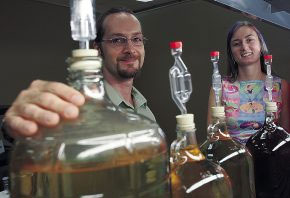 The Associated Press has a feature on South Dakota ethanol producer POET this week, focusing on the company’s ethanol research that “should allow it to squeeze 27 percent more fuel from each acre of the crop.”
The Associated Press has a feature on South Dakota ethanol producer POET this week, focusing on the company’s ethanol research that “should allow it to squeeze 27 percent more fuel from each acre of the crop.”
Sen. Charles Grassley, R-Iowa, who toured the company’s headquarters and research lab last week, said there is only so much ethanol that can be made from corn starch.
“It’s just a way of moving on to have further independence from foreign sources of energy,” he said. “It’s a way of doing more to clean up the environment, and it’s obviously going to put money in farmers’ pockets.”
With the help of a Department of Energy grant, Poet plans to convert its Emmetsburg, Iowa plant into one of the nation’s first commercial cellulosic ethanol plants, using corn stover as well as corn kernels, which would produce more ethanol per acre of corn.


 The
The 
 In an effort to get back on the road, Shared Route… a colorful, biodiesel bus that runs between Portland, Oregon and Olympia and Seattle, Washington… will run on vegetable oil.
In an effort to get back on the road, Shared Route… a colorful, biodiesel bus that runs between Portland, Oregon and Olympia and Seattle, Washington… will run on vegetable oil. “I understand it’s an uphill battle, and I’m going to stay in the fight,” said ITAC Engineers & Constructors Senior Vice President Rick Starnes, a key player in the project who spent more than 20 hours last week walking Brentwood to discuss the plant with residents. “I wouldn’t work this hard if I didn’t think this was the right project for this area.”
“I understand it’s an uphill battle, and I’m going to stay in the fight,” said ITAC Engineers & Constructors Senior Vice President Rick Starnes, a key player in the project who spent more than 20 hours last week walking Brentwood to discuss the plant with residents. “I wouldn’t work this hard if I didn’t think this was the right project for this area.”

 The exective director of the
The exective director of the  Blume, who sounds like one pretty interesting character, is the author of a soon-to-be-released book called “Alcohol Can Be A Gas,” subtitled Fueling an Ethanol Revolution for the 21st Century.
Blume, who sounds like one pretty interesting character, is the author of a soon-to-be-released book called “Alcohol Can Be A Gas,” subtitled Fueling an Ethanol Revolution for the 21st Century.  The
The  NEVC Executive Director Phil Lampert says these include some of the most popular vehicle models. “From a humble beginning of less than 500 FFVs in 1993, we expect that more than 750,000 such FFVs will be produced in the coming year,” he said.
NEVC Executive Director Phil Lampert says these include some of the most popular vehicle models. “From a humble beginning of less than 500 FFVs in 1993, we expect that more than 750,000 such FFVs will be produced in the coming year,” he said.